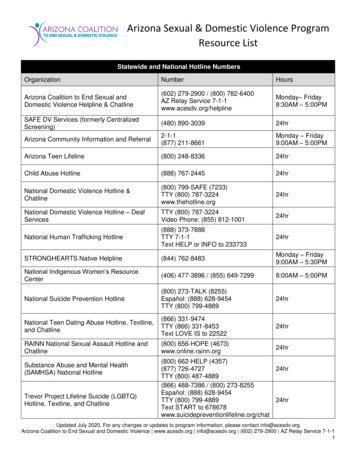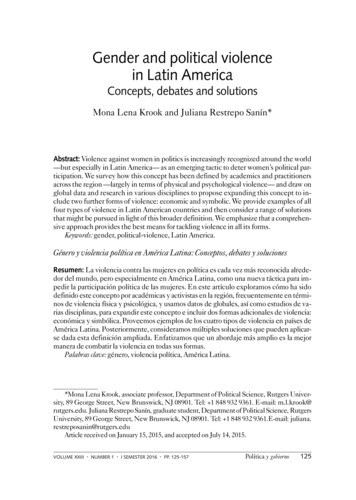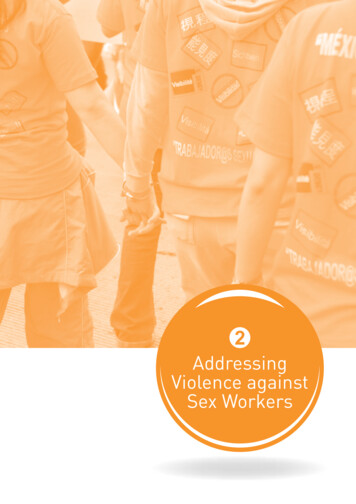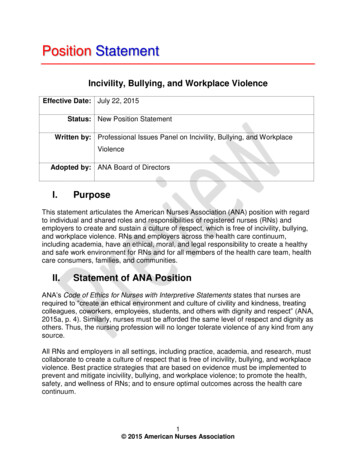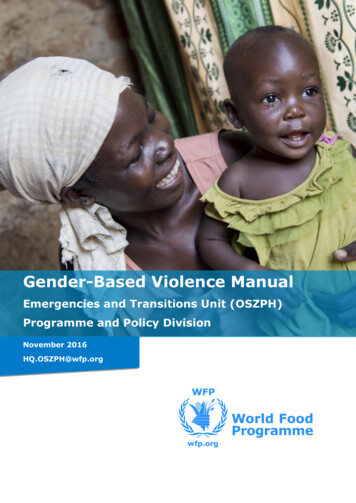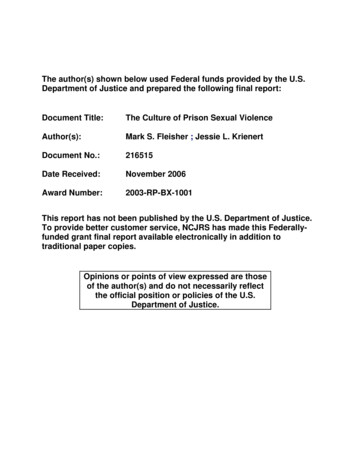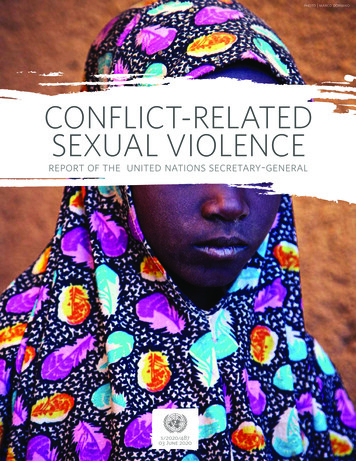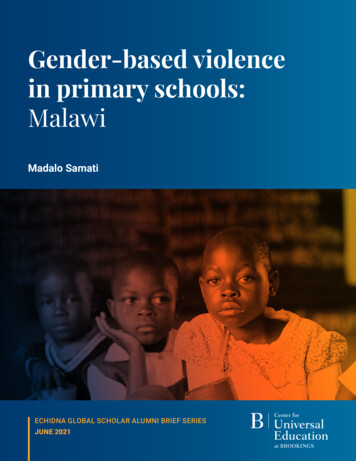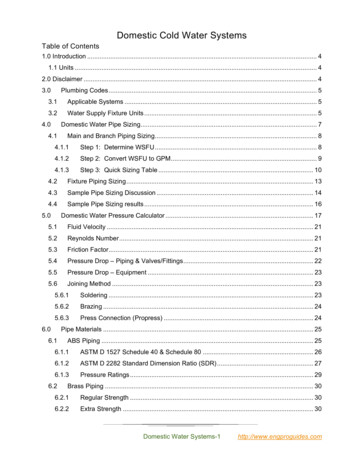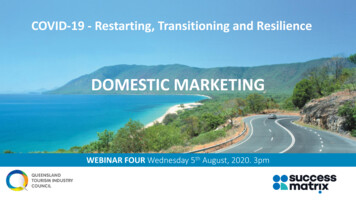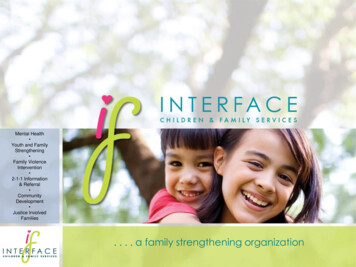
Transcription
Mental Health Youth and FamilyStrengthening Family ViolenceIntervention 2-1-1 Information& Referral CommunityDevelopment Justice InvolvedFamilies. . . . a family strengthening organization
DOMESTIC VIOLENCE 101
What is Domestic Violence?Abuse that occurs within thecontext of an intimate relationship Married couplesDating partnersEx-Intimate partnersYou may have heard . Domestic AbuseIntimate Partner Violence/AbuseDating Violence / AbuseRelationship Violence/Abuse
Characteristics of Domestic Violence A learned behaviorA kaleidoscope of behaviorsand tactics utilized to control a partnerOften difficult to identify, for hidden messages areconveyed through “innocent” behaviors. (ex: sendingflowers to work, buying cell phones)INTENTIONAL and a CONSCIOUS CHOICE
Domestic Violence Statistics 40% of California women experiencedomestic violence in their life time (CPEDV).An estimated 835,000 men are physicallyassaulted by their partner every year (NIJ &CDC).Girls and young women between the ages of16 and 24 experience the highest rate ofintimate partner violence -- almost triple thenational average (US DOJ).
MythsA lower class problemRealitiesBattering is a serious social problemregardless of class, race, culture,income or religionDirectly related to alcoholism Only 1/3 of batterers abuse theirpartners when drinking.The victims faultSome batterers report what they seeas “provocative” behavior, however,many report that the partner didnothing at all to provoke them.Something that only happens Domestic violence is an act ofcontrolling another. Most battererswhen the batterer is out ofare in control of their actions, andcontrolhave deliberate intentions ofdominating their partner.
Forms of Domestic Violence PhysicalSexualPsychological Verbal Mental Emotional IsolationEconomicSpiritualDigitalAbuse may occur frequentlyor infrequently, but in mostcases it tends to escalate inseverity and frequency overtime.
Physical AbusePushingShovingSlappingPullingHair rippingKicking
Spiritual Abuse Using spiritual practices to gain control over another(ex: using scripture)Mocking spiritual beliefs or practicesRestricting access to worship
Emotional Abuse Ridiculing or insulting beliefs, religion, race, ethnicgroup, immigration status, likes, culture, and customsWithholding approval, appreciation, or affection aspunishment Name calling, excessive criticism Humiliating in public or private
Emotional Abuse cont Ignoring a person’s feelings Spying / Stalking Lying about a person and/or theirfamily
Isolation Starts fights when partner wants to visit friends Insults family or friends Needs to ask permission before going out Forced to miss or makeslate to workControls use of vehicle
Mental Abuse Manipulative behavior Threats or intimidation Denying previous actions or events Projecting blame onto the other person Destroying possessions or treasured objects of thevictim (including pets)
Sexual Abuse Controlling how and when sex will take placePunishing by abstaining from sexDisclosing sexual affairs in order to inflict emotionaldistressFalse accusations of sexual infidelityHarassment over a partner’s previous sexualrelationshipsRape, forcing to have sex after having hit ormistreatedAny unwanted touchingReproductive coercion
Financial Abuse Preventing from working or pursuing educationRefusing to share moneyTaking money away or stealing fromThreatening to withdraw financial supportKeeping financial information secretSabotaging employment to maintain financialcontrol
Digital AbuseSharing sexual ornude pictures ofthe person thatwere given inconfidenceExcessive orunwanted textmessaging,instantmessaging, phonecalls or e-mails tocheck up onsomeoneAccessingsomeone'saccounts andchangingpasswords so heor she can nolonger accessthemPosing as aperson andaltering his or heraccounts andprofiles.
The Cycle of ViolencePhase 1:TensionBuildingPhase 3:HoneymoonPhase 1: Tension BuildingAbuser: Yells Criticizes Threatens HumiliatesPhase 2: Violent ExplosionAbuser: Abuses victim physically,emotionally and/orsexuallyPhase 2:ViolentExplosionPhase 3: HoneymoonAbuser: Acts like nothing everhappened Makes promises Pleads for forgiveness Cries Buys gifts
Barriers to Leaving Fear/ threatsIsolationChildhood victimizationEconomic dependenceBeliefs about marriage Children involvedImmigration issuesShameLoveHope that things willget better
LeavingOn average, ittakes a victimseven times toleave beforestaying away forgood.
Common Characteristics andBehaviors of Batterers Low self –esteemJealousDr.Jekyll/Mr. Hyde personalityIsolate their partnersMay have a negative attitudes towards womenPoor communication skillsBlames others for their actions or feelingsTakes things personallyManipulativeOften was a victim on childhood violence
Signs that someone may be in an abusiverelationship: Physical Signs: Bruisesor other injuries Inappropriate clothingfor the season Unusually heavy makeup Poor bodyconsciousness Emotional Signs: Depressed Lowself-esteem Mood swings Alcohol / drug use Anxious or fearful Hints of trouble athome Makes excuses orminimizes actions ofpartner
KEYPOINTA victim is the best expert atdetermining their own levelof safety, and therefore isthe best expert atdetermining how to survive aviolent relationship, even if itmeans staying.
Effects of DV on Children 3.3 million childrenwitness DomesticViolence each year Studies have shownthat even if a child isnot physically abused,witnessing the violencenot only scars the childemotionally, but leadsto behavior that, as anadult, mimics what theylearned from theirparents.
Feelings Experienced by ChildrenExposed to Domestic Violence FearAngerMixed love and angerConfusionLossGuilt/ResponsibilityConfusion, life is unpredictable
How Does Living In A Violent HomeImpact Our Children? May becomedevelopmentally behindLiving in a state of fearof uncertaintyDevelop low self esteemor become withdrawnDevelop a lack of trustwith othersSuffer from depression
Children exposed to violence may Be violent themselves after seeing it in thehome Become overly compliant Experience problems in school Run away from home Begin sexually acting out Be at high risk of teen pregnancy
8 Ways Children and Teens Survive Mental blocking ordisconnectingemotionallyMake it better throughfantasyPhysical avoidanceLooking for love andacceptance (in wrongplaces) Take charge throughcaretakingReaching out for helpCrying out for helpRedirecting emotionsinto positive activities
“A child who lives with violence is foreverchanged, but not forever ‘damaged’. There’s a lotwe can do to make tomorrow better.”Cunningham & Baker, 2007
How can I support survivors? BelieveTry to understand theirdifficult situationUnderstand theiremotional history andtheir feelings of nothaving strength tomake a changeValidate their feelingsand LISTEN Let them know they arenot aloneLocate resources tohelpAcknowledge impact onself / Access localresources to processyour own feelingsIf you see it happen,call the police
Where can I find support?
Crisis Intervention 24/7 DV Hotline: 1-800-636-6738 or 211 Crisis counselingEmergency shelterRestraining order assistanceSafety planningCourt accompanimentSupport groupsInformation and referral
Prevention and Education My Body Belongs to MeTeen Dating ViolencePreventionOutreach & PublicAwarenessBatterers’ InterventionProgramAnger ManagementCo-Custody ParentingParenting Education
Dr.Jekyll/Mr. Hyde personality Isolate their partners May have a negative attitudes towards women Poor communication skills Blames others for their actions or feelings Takes things persona
